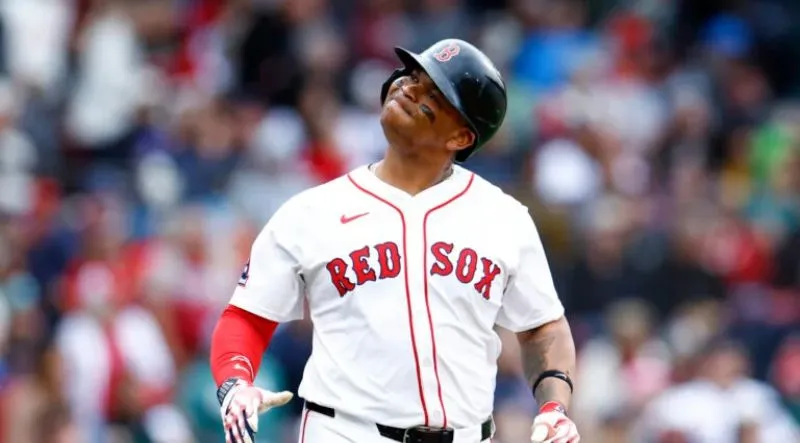In the eyes of many Boston Red Sox fans, the recent Rafael Devers trade feels like déjà vu. Another homegrown star. Another generational talent. Another face of the franchise shipped off. But while it’s tempting to draw a straight line from this move to the infamous Mookie Betts trade in 2020, the truth runs deeper. The Devers trade isn’t a repeat—it’s the epilogue. The closing chapter of a story that started the moment Boston decided to part ways with Betts. It’s not just a transaction; it’s a statement. And that statement echoes the Red Sox’s long, winding struggle between payroll, player development, and identity.
When the Betts Domino Fell
To truly understand the Rafael Devers trade, you have to rewind the clock. In 2020, Mookie Betts was dealt to the Los Angeles Dodgers—a move justified at the time as a business decision. Ownership was focused on resetting the luxury tax and rebuilding a farm system that had grown stale. Betts was due a massive payday, and the Red Sox weren’t willing to meet his demands. The result? A shocking trade that sent waves across MLB and left fans bewildered.
In retrospect, that trade wasn’t just about moving one player. It was about shifting the entire trajectory of the franchise. And in many ways, Rafael Devers was expected to be the centerpiece of the rebuild. Young, talented, and charismatic, Devers carried the burden of becoming the next franchise cornerstone in a post-Betts world.
Rafael Devers: The Heir to the Throne
When Betts left, it was Rafael Devers who rose to fill the vacuum. Already showcasing elite offensive skills, Devers became the team’s offensive engine. From 2020 to 2023, he was the one consistent bright spot on a Red Sox roster plagued by inconsistency. With powerful swings and a knack for clutch moments, Devers endeared himself to fans who were still mourning Betts’ departure.
But something never felt right. Despite Devers’ on-field heroics, the front office never seemed fully committed to building around him. Rumors swirled, extension talks dragged, and as each season passed, it became increasingly clear: the Red Sox were hesitant.
That hesitation culminated in what some see as an inevitable end. The Rafael Devers trade isn’t just about shedding a contract or reshuffling the roster. It’s about finality. It’s about closing the book on the Betts era and admitting, perhaps reluctantly, that the franchise never fully recovered from its most consequential decision.
The Real Message Behind the Devers Deal
By trading Rafael Devers, the Red Sox are doing more than just offloading a player. They’re acknowledging that the rebuild that was supposed to follow the Betts trade has failed to bear the fruit it promised. The prospects haven’t panned out at the expected rate. The team hasn’t found a new identity. And the front office, now fully reshaped since the Betts days, is signaling that it’s time to hit reset—again.
Some might argue that Devers’ defensive limitations or contract size justified the move. But in reality, this trade is symbolic. It marks the true end of the Red Sox team that won the 2018 World Series. With Betts, Bogaerts, Benintendi, and now Devers all gone, the roster is unrecognizable.
How the Fanbase is Processing the Shock
The reaction to the Rafael Devers trade has been predictably emotional. Fans are heartbroken, frustrated, and confused. To many, Devers was the last link to a winning era, and now even that connection has been severed. The comparison to Betts is impossible to avoid, but it also misses the nuance. While Betts was traded at the height of his prime for financial reasons, Devers’ departure feels more like an admission of failure than strategy.
What the Future Looks Like for Boston
So what now? With Devers gone, the Red Sox face an identity crisis. They’ve cleared salary, picked up prospects, and opened the door for a new era. But the blueprint remains unclear. Who is the face of the franchise? Where is the leadership? And what direction is this team heading?
There’s hope in the minors, but hope doesn’t sell tickets or fill the void left by a beloved star. The challenge now isn’t just rebuilding talent—it’s rebuilding trust. The Rafael Devers trade means the Red Sox must work harder than ever to reconnect with a fanbase that’s grown wary of the team’s direction.
Rafael Devers Deserved Better
If there’s one universal truth in this saga, it’s that Rafael Devers gave everything to the Red Sox. He played with heart, passion, and joy. He was never a vocal leader in the traditional sense, but his bat did the talking, and fans listened. To see him traded away not because of declining performance but because of organizational uncertainty feels like an injustice.
Much like Betts, Devers didn’t ask to be the symbol of a front office philosophy. He just wanted to play baseball—and he did it at an elite level. That makes the trade even harder to swallow.
Closing the Chapter, Finally
With Rafael Devers now gone, the ghost of Mookie Betts can finally rest. This isn’t just another shocking trade—it’s the culmination of decisions made years ago. It’s the Red Sox admitting that the path they chose post-Betts never worked the way they hoped. The Rafael Devers trade is the conclusion of a saga that fans never wanted but always saw coming.
It’s not a rerun—it’s the credits rolling. And now, the Red Sox must start writing a brand-new story.

Leave a Reply